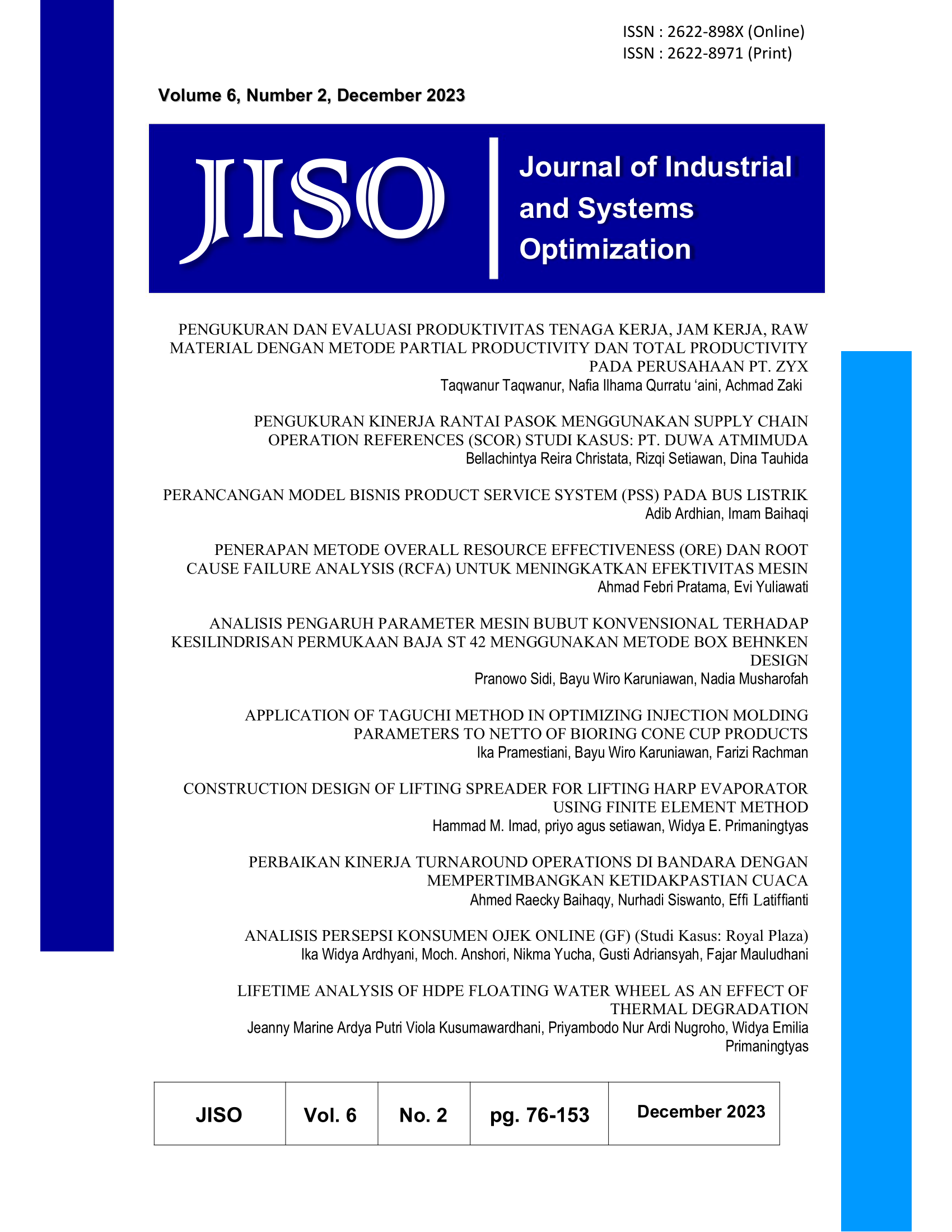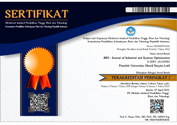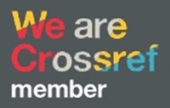ANALISIS PERSEPSI KONSUMEN OJEK ONLINE (GF) (Studi Kasus: Royal Plaza)
DOI:
https://doi.org/10.51804/jiso.v6i2.140-146Keywords:
Kualitas Layanan, SERVQUAL, CSI, IPAAbstract
This study aims to determine the quality of service on customer satisfaction at Royal Plaza Surabaya, based on the results of the analysis of five dimensions of service quality in the Servqual model to create quality services and are expected to have an effect on customer satisfaction. The population of the subjects in this study were 700 people, Grabfood customers in the Royal Plaza area, with a sample consisting of 232 people using the clustering sampling technique. The collected data were analyzed on the Servqual scale, which is described in front (gap) of the expected service quality and the reality received by the customer so that it is known. the level of satisfaction contained in the service attribute which consists of five dimensions of Servqual, namely Tangible (Physical Evidence), Reliability (Reliability), Responsiveness (Responsiveness), Assurance (Assurance) and Empathy (Empathy). The results of the study indicate that the quality of Grabfood's services has not fully met customer expectations because all attributes have negative values. From the results of the integration of the Servqual method and the measurement of the Cartesian diagram, the dominant attribute is in quadrant I, the Tangible attribute value is -1,5303 the Reliability attribute value is -1,2121 the Responsiveness attribute value is -0.7013 the Assurance attribute value is -0.5065 attribute value Empathy is -0.8983. Therefore, the Company needs to maintain service quality and strive to improve its service quality so that it is optimal and puts attributes that are in other quadrants into quadrant I.
Penelitian ini bertujuan untuk mengetahui penelitian kualitas pelayanan terhadap kepuasan pelanggan di Royal Plaza Surabaya, sehingga didasarkan pada hasil analisa lima dimensi kualitas layanan dalam model Servqual untuk menciptakan pelayanan yang berkualitas dan diharapakan berpengaruh pada kepuasan pelanggan. Jumlah populasi subjek dalam penelitian ini pelanggan Grabfood wilayah Royal Plaza sebanyak 700 orang dengan sampel terdiri 232 orang dengan menggunakan teknik clustering sampling data yang terkumpul dianalisa dalam skala Servqual yang menggambarkan kesenjangan (gap) kualitas pelayanan yang diharapkan dan kenyataan yang diterima pelanggan sehingga diketahui tingkat kepuasan yang terdapat pada atribut layanan yang terdiri dari lima dimensi Servqual yaitu Tangible (Bukti Fisik), Reliability (Kehandalan), Responsiveness (Daya Tanggap), Assurance (Jaminan) dan Emphaty (Empati). Hasil penelitian menunjukkan bahwa, kualitas layanan Grabfood belum bisa sepenuhnya memenuhi harapan pelanggan karena semua atribut memiliki kesenjangan bernilai negatif. Dari hasil Integrasi metode Servqual dan pengukuran diagram kartesius atribut dominan berada pada kuadran I, nilai atribut Tangible sebesar -1,5303 nilai atribut Reliability sebesar -1,2121 nilai atribut Responsiveness sebesar -0,7013 nilai atribut Assurance sebesar -0,5065 nilai atribut Emphaty sebesar -0,8983. Oleh karena itu pihak Perusahaan perlu mempertahankan kualitas layanan dan berupaya untuk meningkatkan kualitas layanannya agar optimal dan meletakkan atribut yang berada pada kuadran lain ke kuadran I.
References
Alfonsius, (2020). Pelayanan Transportasi Online di Era New Normal. Journal of Accounting & Management Innovation, Vol.4 No.2, 2020, pp. 76-90.
Cohen, L., L. Manion and K. Morrison. (2007). Research Methods in Education, Sixth Edition. Published in the Taylor and Francis e-library, New York.
Fandy, C. dan Gregorius, C. (2016). Service, Quality dan Satisfaction. Yogyakarta. Andi
Lembaga Demografi FEB Universitas Indonesia. 2019. Dampak sosial ekonomi GO-JEK terhadap Perekonomian Nasioanl di tahun 2018. Terbit 21 Maret 2019.
Lestariningsih, T. (2021). Analysis of Service Quality and Trust on Customer Satisfaction of Ojek Online in Banyuwangi. Jurnal Manajemen Teori dan Terapan, 14(3), 299-323.
Prawitowati, T. dan Bara, F. (2020). Pengaruh Kualitas Layanan, Kepuasan Pelanggan dan Keterikatan Pelanggan Terhadap Loyalitas Pelanggan Grab di Surabaya. Journal of Business and Banking, 10 (1).
Putra, P. S. E., et al. (2023). Metode Servqual Dan Importance Performance Analysis (IPA) Dalam Mengukur Kepuasan Konsumen Terhadap Layanan Di Hygge Social Cafe Pasca Pandemi Covid-19. Jurnal JEBAKU. (3)1, 129-137.
Riduwan, A. Rusyana, et al. (2011). Cara Mudah Belajar SPSS 17.0 dan Aplikasi Statistik Penelitian. Penerbit Alfabeta, Bandung.
Riyani, D., Larashat, I., & Juhana, D. (2021). Pengaruh Harga Dan Kualitas Pelayanan Terhadap Kepuasan Pelanggan. Majalah Bisnis & IPTEK, 14(2), 94–101. https://doi.org/10.55208/bistek.v14i2.233
Syarif, A. dan Widodo, A. (2020). Analisis Kualitas Pelayanan Dan Kepuasan Konsumen Menggunakan Metode Customer Satifaction Index (CSI) dan Important Performance Analysis (IPA) Pada Bengkel AUTO2000 Asia Afrika Bandung. JIMEA (Jurnal Ilmiah MEA (Manajemen, Ekonomi, dan Akuntansi), 4(3), 685-701.
Suliyono, J. (2010). 6 Hari Jago SPSS. Cakrawala, Yogyakarta.
Tjiptono, F. and Gregorius, C. (2011). Service, Quality & Satisfaction. Penerbit Andi, Yogyakarta.
Downloads
Published
Issue
Section
License
Copyright (c) 2023 JISO : Journal of Industrial and Systems Optimization

This work is licensed under a Creative Commons Attribution-ShareAlike 4.0 International License.
With the receipt of the article by JISO Editorial Board and the decision to be published, the copyright regarding the article will be transferred to JISO. The copyright transfer form can be downloaded here.
JISO has the right to multiply and distribute the article and every author is not allowed to publish the same article that was published in this journal.
JISO is licensed under a Creative Commons Attribution-ShareAlike 4.0 International License.
Under the following terms:
Attribution — You must give appropriate credit, provide a link to the license, and indicate if changes were made. You may do so in any reasonable manner, but not in any way that suggests the licensor endorses you or your use.
ShareAlike — If you remix, transform, or build upon the material, you must distribute your contributions under the same license as the original.














